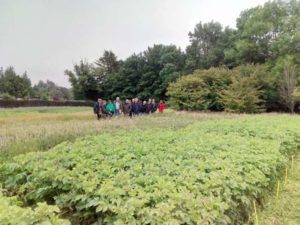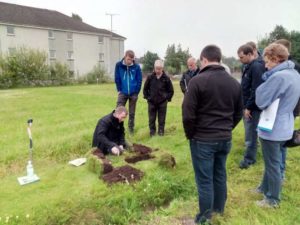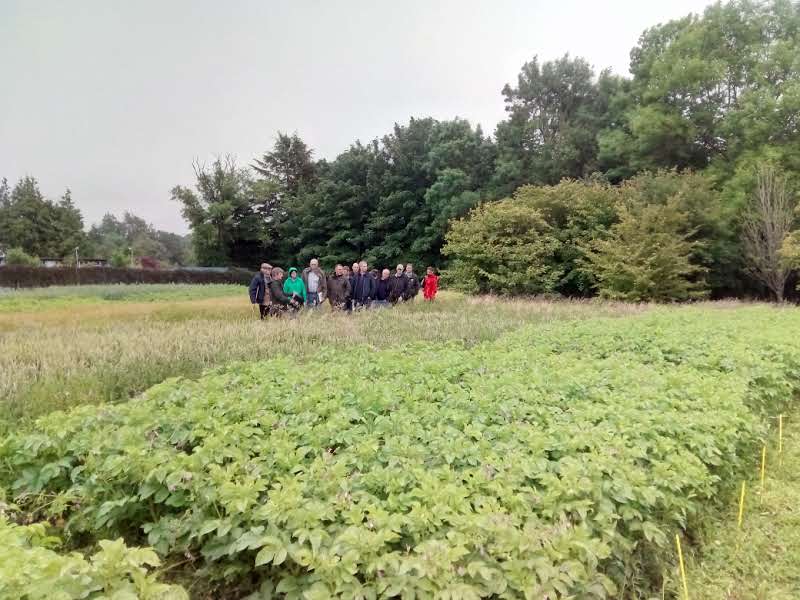Seeing is Believing! How pH & N:P:K Fertilisers impact on Crops & Livestock – Event Summary
19 July 2017Getting the most from your farm starts by managing the soil and getting the basics right
This meeting was held at SRUC’s Woodlands Field, Craibstone. Since 1922 a 6 year rotations trial investigating the long-term effects of 6 different fertiliser strategies has been running at  Woodlands Field, and in 1961 pH trial plots were established (ranging from pH 4.5 to pH 7.5) within an eight course rotation. Both of these trials are extremely useful teaching resources as well as the source of scientific study in soil / plant interactions.
Woodlands Field, and in 1961 pH trial plots were established (ranging from pH 4.5 to pH 7.5) within an eight course rotation. Both of these trials are extremely useful teaching resources as well as the source of scientific study in soil / plant interactions.
Those in attendance had the opportunity to see these long term pH and N:P:K fertiliser trials to reinforce the importance of growing crops at the optimum pH (pH 6.2) and the sensitivity of crops at other pH’s from pH4.5 – pH7.5. The fertiliser trials also highlighted the importance that each major nutrient plays on the range of different cereal crops as well as potatoes and grass.
After the tour, a presentation backed up what was seen with data going back to when the trials started in the 1920’s and 1960’s.
David Ross highlighted the importance of visually assessing your soil structure, using the Visual Evaluation of Soil Structure (VESS) handout. Later in the day, David also showed the differences between various GPS soil sampling techniques, to raise awareness of the importance of how soils are analysed using GPS technology, and the range of services available.
Robin Walker highlighted take home messages, showing data that highlights the optimum pH for the range of crops grown, as well as yield results for the differing fertiliser trials. A good discussion occured at this point, utilising Alex Sinclairs depth of knowledge on the subject as well.
Downloa![]() d the information handouts & presentation slides that were available on the day from the links below.
d the information handouts & presentation slides that were available on the day from the links below.
Ensuring optimal soil structure and pH is critical to maximising production from any applied nutrients. To find out more about how to improve your farm productivity whilst reducing your carbon footprint, visit the Farming For a Better Climate website.
- Technical Note (TN656): Soil Information, Texture & Liming Recommendations
- • Web based access to information on your soils on your farm is described. • Soil texture classes of mineral soils are described and identified by hand texturing. • Liming recommendations for different soils and managements are tabulated.
- Topics: Soils
- Technical Note (TN668): Managing Soil Phosphorus
- Efficient soil P management is challenging due to the varying ability of soils to mediate and regulate plant available forms of P. Farmers and land managers in Scotland are now able to access farm level information about their soils making it possible to provide more accurate P management advice.
- Topics: Crops and Soils
- Healthy Grassland Soils – guide to soil assessment
- This is publication from Newcastle University, ADAS, SRUC & AHDB can be used to help you assess the health of your grassland soils
- Topics: Soils, Climate Change, Water Management and Crops and Soils
- Valuing Your Soils – Practical Guidance for Scottish Farmers
- This brochure includes useful information about Scotland's agricultural soils and practical advice outlining the upfront financial savings and business benefits of better soil management and the efficient use of resources. Action and problem-specific 'field-sheets' are designed for busy farmers with limited time for reading.
- Topics: Soils, Climate Change, Water Management and Crops and Soils
- Soil management and its impact on farm productivity and the environment
- This is a summary sheet produced by SRUC of how good soil management impacts farm productivity & the environment.
- Topics: Soils, Climate Change and Water Management
- Farming For A Better Climate: Practical Guide – Soil Management
- Topics: Soils
- Practical Guide: Greenhouse Gas Emissions
- This Practical Guide looks at the main agricultural greenhouse gases and how farm emissions might be reduced.
- Topics: Climate Change
- Farming For A Better Climate: Practical Guide – Improving Soil Quality
- This Practical Guide concentrates on how we can improve soil quality to help us to adapt to climate change.
- Topics: Soils
- Practical Guide: Managing Soil Phosphorus
- This Practical Guide will help you manage the phosphorus in your soils. It will help you understand the risk of phosphorus pollution and how you can reduce bagged fertiliser costs in grassland by incorporating nitrogen fixing clover into your sward.
- Topics: Soils, Climate Change and Water Management
- Practical Guide: Soil sampling I – How to take a soil sample
- This practical guide details what is required to take a soil sample for analysis that is representative of the area sampled.
- Topics: Soils, Climate Change and Water Management
- Practical Guide: Soil sampling II – Benefits to your business
- This practical guide details how soil sampling can benefit businesses by increasing productivity and create efficiencies on fertiliser inputs through better nutrient planning.
- Topics: Soils, Climate Change and Water Management
Sign up to the FAS newsletter
Receive updates on news, events and publications from Scotland’s Farm Advisory Service

